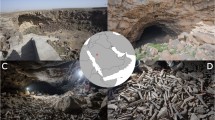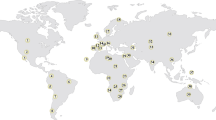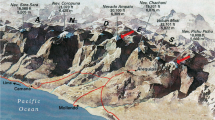Abstract
Ostrich eggshell beads and fragments collected from SDG site reflect primordial art and a kind of symbolic behavior of modern humans. Based on stratigraphic data and OSL dating, these ostrich eggshell beads are probably in Early Holocene (< 10 ka BP). Two different prehistoric manufacturing pathways are usually used in the manufacture of ostrich eggshell beads in Upper Paleolithic. According to statistic analysis of the characteristics of ostrich eggshell beads, Pathway 1 is identified from these collections. In pathway 1, blanks are drilled prior to being trimmed to rough discs. They exhibit great potential for the study of the origin of primordial art and the development of ancient cultures and provide important data for studying behavioral options adopted by hominids in SDG area. In addition, they bear important implications for the origin of modern humans in East Asia.
Similar content being viewed by others
References
Zhang X L. Primordial Art and Spirit in China (in Chinese). Chongqing: Chongqing Press, 2005. 28–62
Bouzouggara A, Bartonb N, Vanhaerend M, et al. 82000-year-old shell beads from North Africa and implications for the origins of modern human behavior. Proceedings of the National Academy of Sciences, 2007, 104: 9964–9969
Henshilwood C, d’Errico F, Vanhaeren M, et al. Middle Stone Age shell beads from South Africa. Science, 2004, 304: 404
Gao X, Wang H M, Pei S W, et al. Scholars unearthed the Shuidonggou site again in China (in Chinese). China Cultual Relics News, 12-19-2003, 1–2
Liu D C, Chen F Y, Zhang X L, et al. Preliminary comments on the paleoenvironment of the Shuidonggou Locality 12 (in Chinese). Acta Anthropol Sin, 2008, 27: 295–303
Beck H C. Classification and nomenclature of beads and pendants. Archaeologia, 1928, 77: 1–76
Plug I. Bone tools and shell, bone and ostrich eggshell beads from Bushman Rock Shelter (BRS), eastern Transvaal. South African Archaeol Bull, 1982, 37: 57–62
Kandel A W, Conard N J. Production sequence of ostrich eggshell beads and settlement dynamics in the Geelbek Dunes of the Western Cape, South Africa. J Archaeol Sci, 2005, 32: 1711–1721
Orton J. Later Stone Age ostrich eggshell bead manufacture in the Northern Cape, South Africa. J Archaeol Sci, 2008, 35: 1765–1775
Zhao Z K, Yuan Q, Wang J K, et al. On the amino acid composition and microstucture of fossil ostrich eggshells from Sinanthropus site, Choukoutien (in Chinese). Vertebrata Palasiatica, 1981, 19: 327–336
She D W. A study of eggshell with scanning electron microscope (in Chinese). Acta Zool Sin, 1995, 41: 243–255
An Z S. New finds of ostrich eggshell fossils in Northern China and preliminary study of microstruture (in Chinese). Vertebrata Palasiatica, 1964, 8: 374–382
Derevianko A P. The Middle to Upper Paleolithic transition in the Altai. Archaeol, Ethnol Anthropol Eurasia, 2001, 7: 70–103
Derevianko A P, Rybin E P. The earliest representations of symbolic behavior by Paleolithic humans in the Altai Mountains. In: Derevianko A P, eds. The Middle to Upper Paleolithic Transition in Eurasia: Hypotheses and Facts. Novosibirsk, 2005. 232–255
Errico F, Vanhaeren M, Wadley L. Possible shell beads from the Middle Stone Age layers of Sibudu Cave, South Africa. J Archaeol Sci, 2008, 35: 2675–2685
Kuhn S L, Stiner M C, David S R, et al. Ornaments of the earliest Upper Paleolithic: New insights from the Levant. Proceedings of the National Academy of Sciences, 2001, 98: 7641–7646
Vanhaeren M, d’Errico F, Stringer C, et al. Middle Paleolithic shell beads in Israel and Algeria. Science, 2006, 312: 1785–1788
McBrearty S, Brooks A S. The revolution that wasn’t: a new interpretation of the origin of modern human behavior. J Hum Evol, 2000, 39: 453–563
Shpakova E G, Derevianko A P. The interpretation of odontological features of Pleistocene human remains from the Altai. Archaeol Ethnol Anthropol Eurasia, 2000, 1: 125–138
Shpakova E G. Paleolithic human dental remains from Siberia. Archaeol Ethnol Anthropol Eurasia, 2001, 8: 64–76
Ambrose S H. Chronology of the Later Stone Age and food production in East Africa. J Archaeol Sci, 1998, 25: 377–392
Bednarik R G. The role of Pleistocene beads in documenting hominid cognition. Rock Art Res, 1997, 14: 27–41
Radcliff-Brown A R (Writer), Liang Y (Translator). The Andaman Islanders (in Chinese). Guilin: Guangxi Normal University Press, 2005. 359–365
Kuhn S L, Stiner M C. Body ornamentation as information technology: towards an understanding of the significance of early beads. In: Mellars P, Boyle K, Bar-Yosef O, et al., eds. Rethinking the Human Revolution: New Behavioral and Biological and Perspectives on the Origins and Dispersal of Modern Humans. Cambridge: MacDonald Institute of Archaeology, 2007. 45–54
Kuhn S L, Stiner M C. Paleolithic ornaments: Implications for cognition, demography and identity. Diogenes, 2007, 54: 40–48
Wong K. The morning of the modern mind. Sci Am, 2005, 292: 74–83
Author information
Authors and Affiliations
Corresponding author
Additional information
Supported by the National Basic Research Program of China (Grant No. 2006CB 806400) and Specific Basic Research Program of Ministry of Sciences and Technology of China (Grant No. 2007FY110200), National Natural Science Foundation of China (Grant No. J0630965) and Knowledge Innovation Project of the Chinese Academy of Sciences
About this article
Cite this article
Wang, C., Zhang, Y., Gao, X. et al. Archaeological study of ostrich eggshell beads collected from SDG site. Chin. Sci. Bull. 54, 3887–3895 (2009). https://doi.org/10.1007/s11434-009-0620-6
Received:
Accepted:
Published:
Issue Date:
DOI: https://doi.org/10.1007/s11434-009-0620-6




